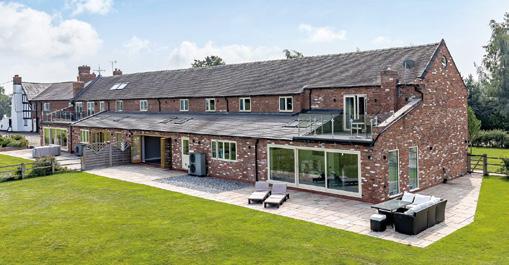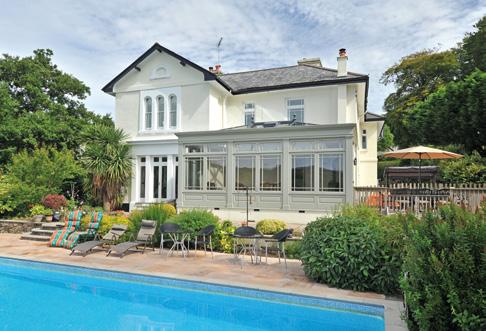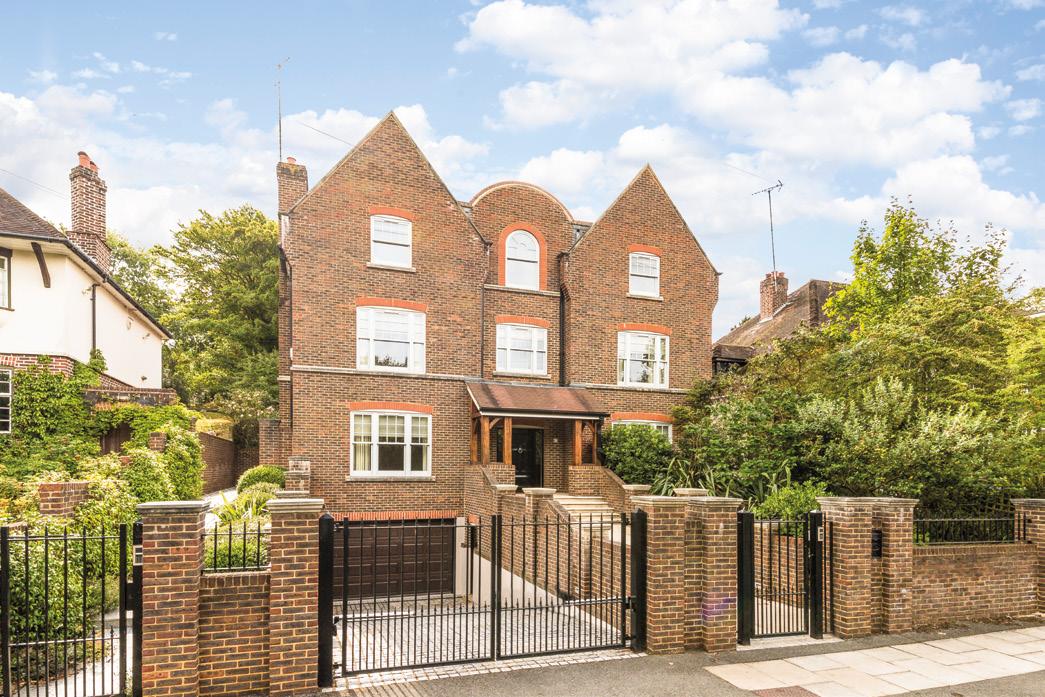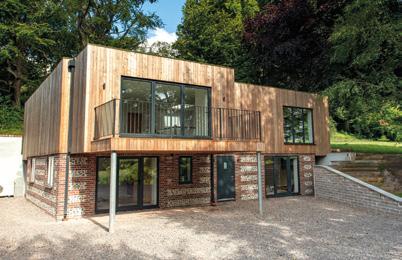
9 minute read
PRESSURES FAVOUR FLEXIBILITY
Increased demand has added to upward pressure on rents, but the package matters as much as the price, rewarding those able to be flexible.
Even in anticipation of lockdown, rural areas saw an influx of demand from city residents seeking country boltholes. Time was short, so they could not be price-sensitive. Post-lockdown, a similar surge occurred, though this time of people looking to move permanently to a more rural location, and to rent whilst finding a place to buy. Having, in many cases, agreed the sale of their current home and under pressure to agree a completion date, their time was short, too. They wanted to rent for a year at the very most (which is not always welcomed by landlords), but time pressures made them less price-sensitive (which is). Added to a background of rising general demand, this Covid-driven activity has pushed rents up, at least for the kind of houses most want. What kind is that?
In relation to lease, location and property, convenience and flexibility triumph over everything else. Tenants will pay for options to break early and to extend. They will of course pay for convenient locations, but the short walk to the town centre and train station now has to compete with the ability to walk directly from home into open countryside. Similarly, as ever, tenants want warm, high quality homes where everything works properly, but now they also value options such as being able to close off a private corner within those big, open plan living areas, and outdoor spaces suited to entertaining even on chilly autumn evenings.
Flexibility, though, works both ways: landlords are concerned about reduced legal rights coming on top of higher taxes and tighter, more expensive credit. Combined with rising capital values, this is persuading a few to sell. Most, though, are simply being more cautious about whom they accept. This makes tenants able to offer larger up-front payments highly attractive. This can make sense for tenants too, provided they have cash or can access low loan rates: the difference between rent paid monthly and paid six months, or even a year in advance, could appreciably exceed the cost of the loan. The security that such an arrangement brings to landlord and tenant alike, relieves pressures on both.
Opposite page:
Top: West Sussex £3,000 pcm (Chichester)
Bottom: Kent £7,000 pcm (Sevenoaks)
What will £1,000,000 buy in the country?
WHAT WILL £1,000,000 BUY IN THE COUNTRY?


More than four times the current UK average house price of £235,000 (Land Registry), what a million pounds secures, varies greatly across the country.
This page, clockwise from the left: Kent £1,250,000 guide
(Cranbrook)
Gloucestershire £800,000 guide (Chipping Campden)

Yorkshire £950,000 guide (Yorkshire)
Devon £1,150,000 guide (Exeter)
Opposite page, clockwise from the top: North Devon £795,000 guide (Barnstaple)
Norfolk £1,175,000 guide (Norwich)
Cheshire £1,050,000 guide (Chester)


Surrey £975,000 guide (Oxted)



WHERE AM I WORKING TODAY?
Central London demand is being driven by people keen to be back at their office, but having to work some days from home. Needing somewhere to live where this is practical, they are taking advantage of greater choice, while it lasts.


There is an irony here. Amidst accusations of staff getting too comfortable working from home and being in denial about its shortcomings, central London office employees want nothing more than to get back to their desks full time. In most cases, it’s why they live, where they live, having prioritised location over space. True, incomers are typically astonished to find how strong community life can be in places like Holland Park and Pimlico and yes, to be part of a quieter, more relaxed London has been an enjoyable revelation for many – but they still want to get out and physically go to work.
To allow social distancing, many businesses are restricting office numbers and some big employers, including NatWest and Standard Life Aberdeen, have announced that most staff will not be returning to their City offices until 2021. Suddenly, the pied-à-terre you took thinking you would only be there whilst you slept, has to double up as your office as well. Perhaps the most affected have been couples in small one bedroom flats, each facing another day of hours spent participating in different video meetings. Like so many others, they need at least one more room. With a door.
MORE CHOICE FOR TENANTS – FOR NOW
The good news for central London renters able to move anytime soon, is that they can probably afford that extra room. Demand from tourists for short term lets has been close to zero, pushing thousands of Airbnb apartments onto the longer term rental market. With numbers of wealthier foreign students also much reduced, supply is high and rents have adjusted accordingly. As well as enabling locals to trade up, much firmer rental markets further afield have cut the central vs. suburban price differential, tempting others to move closer in. If you want to live more centrally, now is the time to make that move.
Commit Long
Tenants who feel in a stronger negotiating position sometimes push for a break clause after just six months. In the current market, however, this looks self-defeating. If anything, it makes sense to fix for a longer term, whilst rents are more affordable. Most landlords will consider up to three years.
Opposite page: Top: Lupus Street SW1 £2,350,000 guide (Pimlico)

Bottom: Wimbledon Park SW19 £14,950 pcm (Wimbledon)

Below: Queensway W2 £2,275 pcm (Holland

SALES: NEVER BUSIER
As with Lettings, the London Sales market shows strong differences between centre and suburbs – though both are exceptionally busy. Even allowing for the lockdown period, our Pimlico & Westminster office is set for its best year ever. So who is buying? In most cases, it is existing local residents who were renting. Attracted by lower stamp duty (two bed flats in SW1 start at around £650,000) and low interest rates they, too, are taking advantage of an improved supply. Significant demand is also coming from families selling a less central home and opting for the ‘flat in London, house in the country’ lifestyle which, until recently, was impractical for working couples (this is also likely to increase calls for a season ticket which can be legally shared). Is there any demand from overseas buyers? Yes, most certainly and, in common with almost all who are registering with us now, they want to be long-term owner occupiers, which augurs well for the areas in which they are buying.
Broad Social Change
Beyond central London, higher levels of supply and demand there, too, reflect a broader picture of social change. Our Teddington office is seeing a higher turnover of stock at all price levels than for some years. There and across London it seems, lots of residents are on the move. Their reasons why, vary greatly, but it is rare for coronavirus to not be a factor, as people re-evaluate their working lives and their relationships with their home and community and strive for something better. What they want has changed from a few months ago. It is more nuanced and sometimes harder to define. We are fully aware of this and, if you think we can help, we promise to listen, to avoid making assumptions – and to help you find it.
Dallington Hall Northampton
Built for an outstanding parliamentarian and later owned by Earl Spencer, this elegant house epitomises the subtle transition from Queen Anne to Georgian styles. It also begs the question: what are triglyphs and guttae?



Even before it was built in the 1720s, Dallington Hall had history. It replaced the home of Sir Richard Rainsford, an MP during Charles II’s Cavalier Parliament and so successful a lawyer that he became the head of the judiciary in England and Wales. Sir Joseph Jekyll, the man who demolished Rainsford’s home to build Dallington, didn’t do quite so well as a lawyer: as Master of the Rolls, he was only the country’s second most senior judge. As a parliamentarian, however, Jekyll was extraordinary. Across 40 years, he was returned as an MP no fewer than twelve times. Described by the poet Alexander Pope as “a Whig who never changed his principles or his wig”, Jekyll championed electoral reform, anti-corruption laws and, via the 1736 Gin Act, alcohol restriction – prompting such public anger, he needed armed guards at his door.
Dallington Hall is described by Historic England as featuring “Doric end pilasters under entablatures with triglyphs and guttae”. For the uninitiated, pilasters are merely decorative, whereas Doric columns, hold the building up. Triglyphs are the groups of three vertical channels in the tablet above the column and they must have six, small, peglike features – the guttae – underneath. A plain entablature without both triglyphs and guttae, is not Doric, but Tuscan. Such distinctions are, architectural historians assure us, very important.

Building new homes involves a constant flow of information and materials between planners, lawyers, surveyors, construction teams and their suppliers. Lockdown stopped that flow as suddenly as freezing a movie in the middle of a chase. When the action started again, some of the pieces had been moved.
The more obvious differences were macro, big picture concerns. Increasing the supply of new homes is a political priority, so the loss of a period during which 60,000 should have been completed was always going to affect government policy. Thus, unsurprisingly, the government moved a key date within the current Help to Buy scheme, giving an extra two months for construction completion to 28 th February 2021. The scheme is still scheduled to be replaced on 1 st April 2021. Much more dramatically, the government also announced a ‘Build build build’ programme, consisting of enhanced permitted development rights from September 2020, plus a much broader set of reforms – Planning for the Future – with a consultation closing date of 29 th October 2020. The September changes will allow greater freedoms to, without planning permission, extend houses and to convert commercial properties to residential. The broader reforms promise a far more wide-ranging impact: “...homes will be built quicker by ensuring local housing plans are developed and agreed in 30 months – down from the current 7 years it often takes”. The paper includes proposals that every area should have a local plan and, controversially, that no objections will be heard to developments deemed to be in accordance with it. To see and comment upon it, please visit
For contractors and professionals involved in the construction process, lockdown highlighted how fragmented and complex that process is, and how weather-dependent (almost countrywide, the lockdown weather was sunny but not too hot: perfect for building). As in other areas of life, we believe this will accelerate a trend which was happening anyway: in this case, the move towards modular home construction. Gaining acceptance from local authorities, lenders and buyers alike, modular construction involves most work being done off-site, under cover. Safer, cleaner, easier and much more convenient for construction workers, it is also faster (a major government objective) because construction of the house can take place at the same time as the preparatory groundworks, and in any weather.
Developers and house building companies, meanwhile, emerged from lockdown into a market in which buyer demand is strong, but different. Investment buyers, especially from overseas, are rare, as are those keen on ultra high rise buildings. A significantly higher than usual proportion of buyers are moving to be closer to family. They ask about broadband speeds high enough to facilitate video calls taking place whilst someone else live-streams a movie. They ask about where they might charge their electric car and, sometimes, their electric bicycle, too. They want some outside space in which to relax and to grow something edible, if only a few herbs. And they are interested in community. In short, new home buyers, at least in the middle and upper markets, are taking a notably more holistic view of the place in which they are thinking of living, as well as the space. Over time, this will reward higher quality, more forward thinking developers, especially where their work can integrate with more enlightened urban planning.

Rate Cuts For Low Ltv Loans
Even though we believe interest rates have bottomed out, we anticipate rate cuts for those fortunate enough to need loans which are low, relative to the value of the property (generally 60% or less). For lenders, this is a large, low risk, highly attractive part of the market.

We expect lenders to use higher margins on their other products to compete aggressively for low loan-to-value business. Indeed, at the time of writing, HSBC has just cut its 2-year fixed rate to 1.14% and its 5-year fixed to a market leading 1.34%, but only for borrowers needing no more than 60% of value.
Lenders Tighten Credit Scoring
To help them cope with demand, lenders are raising the credit scores they require for both owner occupiers and landlords, turning away borrowers who do not meet the new, tougher criteria. We think it will be a long time before lenders return to pre-pandemic rules, highlighting once again the importance of maintaining a strong credit history.
55+ INTEREST ONLY MORTGAGE FROM PRIVATE BANK
Private bank Hampden & Co has recently launched a new retirement interest only mortgage for personal clients over the age of 55. Although this type of product has been around for a while, it is new territory for private banks, whose entry increases its potential as a valuable estate planning tool.
Holiday Let Loans In Demand
Lenders are expecting continued growth in the strengthening holiday let mortgage market. In anticipation, the Leeds Building Society has just relaunched a new fixed-rate holiday let product for up to 70% loan-to-value.

For independent advice, contact Private Finance on 0870 600 1650 or jackson-stops@privatefinance.co.uk.



